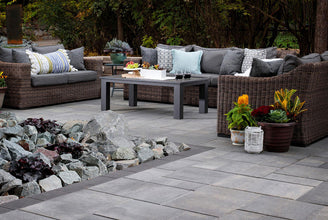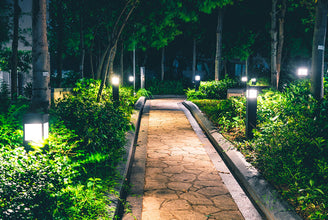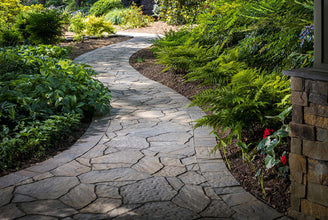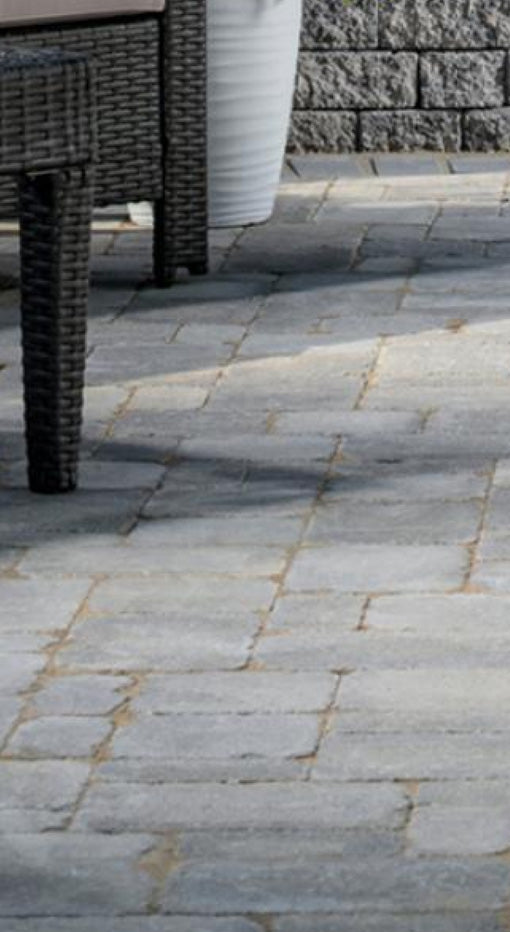Landscape Lighting Design 101

Your home is your castle and you want to show it off at all times, including at night. Outdoor lighting is not just a cosmetic issue, but also one of safety. A dark path or yard could cause you to trip or fall.
It’s also an invitation for thieves who might want to break in. Light is a good deterrent.
At the very least you want path lighting in the front driveway and all walkways in the front and back yards. There are many options to consider in terms of design, installation, and fixtures. You don’t have to break the bank, either.
We’re here with a guide for creating the best lighting for outdoor paths.
Coming Up With a Plan
Before doing anything, you need to come up with a lighting design. It’s a good idea to walk the pathways and other landscaping features in your yard during the day to see what you’d like to highlight. You might have a garden, trees, a deck/patio, or a water feature that will look magical with the right illumination.
Don’t forget to note the size and shape of the driveway and all walkways. Do you have a long, straight path, a curved drive, or one that meanders around the lawn? In addition, take note of places where lighting is needed to safely enter and exit your home after dark.
Create a Sketch of Your Yard
It’s vital to have a drawing or layout of the front and back yard. Include all structures and landscaping features, such as the driveway, pathways, patio/decks, garden, trees/shrubs, benches, and any other important focal points.
You may be able to do this yourself, either by hand or using special software. Or you can hire a landscape designer who specializes in outdoor lighting. It’s important to note the approximate height, length, and width of each object on your sketch.
Be sure to note any existing lights, as you’ll need to incorporate that into your new plans. This may even dictate the type of lighting system and voltage you’ll need, whether 120V or 12V.
Landscape Lighting Necessities
Of course, you need fixtures, but you will also need some lighting accessories in order to connect the lights and provide the power to turn everything on.
Here are the 4 major components you’ll need:
- Lighting fixtures (more on that in a minute)
- Transformer – This reduces the voltage so you use less electricity and make your system safer
- Connectors – These are wire fixtures so that all the lights can be connected
- Low-voltage power cable – This relays electricity from the transformer to the fixtures
You can buy all four components as part of a DIY kit or order through your landscape designer.
Determine Your Budget
As with any home project, your budget will determine what you can afford to do. What is the cost of landscape lighting? Fixtures can cost anywhere from $3 to $400 per piece, as well as light bulbs. You can buy halogen bulbs for around $4 - $10, while LED bulbs are usually $20 - $40.
Though LED lights might cost more upfront, they often last longer than old-fashioned halogen bulbs, while also helping you save energy. Cables can cost around 50 cents per foot, while transformers can cost as much as $1,000.
If you’re handy, you might be able to install the lighting yourself. Otherwise, you will need to hire someone to do it for you. That will be another cost to consider in your budget.
Choosing Lighting Fixtures for Path Lighting and More
Any path lighting help guide must include an overview of the most important element. The light fixtures.
There are many different options, which can make things complicated. You’ll need to consider the style of your home and your property itself. Remember your plan and which features you want to highlight.
Lighting options:
White path lights – Evenly spaced, tall, white lights work well with pathways that are dark or gray stone or concrete. Space the lights evenly on both sides of the pathway so there are no missteps. If the lights illuminate at an angle, it will cover a wider area.
Angled lights – A modern home will look good with lights that have geometric shapes, clean lines, and hard angles. Tall, angled lights will cast more light while keeping with a contemporary vibe.
Mood lighting – Sometimes you want hardware that will cast a warm glow rather than a harsh, bright light. Short bollard style fixtures cast the light downwards. They’re also ideal for highlighting landscaping features such as the edge of the patio or walkways.
Light both sides – Some fixtures are designed so that the light beams through slots on both sides. This is another cool way to illuminate pathways and garden features.
Candlelight – Old-fashioned ground-level lanterns add charm and warmth to traditional or historic homes. Even if your home is new, lanterns will create a vintage vibe. You can place these along the walkways, steps, and at the entryway.
Space saver lighting – If you need to make the best use of a small space, choose taller path lights and place them amongst the trees and shrubs around your yard. Lights with 360-degree coverage can provide ambient lighting for outdoor entertainment areas and pathways.
Downlights – Downlights have become popular recently as they can illuminate large areas. Classic, black downlights will blend perfectly with other landscaping features so they are unobtrusive, too.
Get creative – You don’t have to stick with typical lighting. Go outside the box and choose fixtures with distinct colors or unusual materials such as brass or bronze. This is a great option if you have stone or wood architecture as the metals reflect well off of those surfaces.
Lighting stairs - You can use path lights to illuminate stairs. Ones that offer 360-degree ambient light will help you see where you’re going. You can stagger the lights on both sides of the stairs to make sure you have enough illumination.
Casting spotlights – To highlight certain features such as arches, trees, and waterfalls, think about adding spotlights. These lights are adjustable so you can aim them as low or high as want.
Step lights – If you have a narrow path or there isn’t room to put proper lights, try adding step lights on outdoor stairs. Dual small step lights on every other step will provide enough visibility. This type of lighting can also be used on walls or other landscape features.
Choose Your Outdoor Lighting Scheme
If you’re ready to illuminate your outdoor spaces, there is no shortage of options. This guide will help you decide on path lighting and other landscaping features.

Questions?
Give us a call!
With over 25 years’ experience designing and installing hardscapes in the field, our team has the expertise to address nearly any hardscape question you might have.


Saluting Our Heroes
We’re grateful to the men and women of our armed forces who put their lives on the line to protect our freedom. That’s why we donate a percentage of every sale we make to the Wounded Warriors Project.




